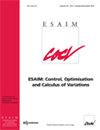速度耦合弹性系统的最优半群正则性:退化分数阶阻尼情况
IF 1.2
3区 数学
Q4 AUTOMATION & CONTROL SYSTEMS
Esaim-Control Optimisation and Calculus of Variations
Pub Date : 2022-05-16
DOI:10.1051/cocv/2022042
引用次数: 5
摘要
在这个笔记中,我们考虑两个阻尼弹性系统的抽象系统。阻尼涉及平均速度和主算子的分数阶幂,幂在$[0,1]$中为$\theta$。对阻尼矩阵进行简并,使正则性分析更加精细。首先,结合频域方法和乘法器技术,证明了下面半群的正则性:\begin{itemize}\item 对于每个$\delta>1/2\theta$,对于$(0,1/2)$中的每个$\theta$,这个半组都是Gevrey类$\delta$。\item 对于$\theta=1/2$,半群是解析的。\item 对于每个$\delta>1/2(1-\theta)$,对于$(1/2,1)$中的每个$\theta$,这个半组都是Gevrey类$\delta$。\end{itemize}其次,我们分析了点谱,并推导了正则性结果的最优性。我们还证明了对于$\theta=0$或$\theta=1$,半群是不可微的。这些结果大大改进了最近在\cite{ast}中提出的一些结果。本文章由计算机程序翻译,如有差异,请以英文原文为准。
Optimal semigroup regularity for velocity coupled elastic systems: a degenerate fractional damping case
In this note, we consider an abstract system of two damped elastic systems. The damping involves the average velocity and a fractional power of the principal operator, with power $\theta$ in $[0,1]$. The damping matrix is degenerate, which makes the the regularity analysis more delicate. First, using a combination of the frequency domain method and multipliers technique, we prove the following regularity for the underlying semigroup:
\begin{itemize}
\item The semigroup is of Gevrey class $\delta$ for every $\delta>1/2\theta$, for each $\theta$ in $(0,1/2)$.
\item The semigroup is analytic for $\theta=1/2$.
\item The semigroup is of Gevrey class $\delta$ for every $\delta>1/2(1-\theta)$, for each $\theta$ in $(1/2,1)$.\end{itemize}
Next, we analyze the point spectrum, and derive the optimality of our regularity results. We also prove that the semigroup is not differentiable for $\theta=0$ or $\theta=1$. Those results strongly improve upon some recent results presented in \cite{ast}.
求助全文
通过发布文献求助,成功后即可免费获取论文全文。
去求助
来源期刊

Esaim-Control Optimisation and Calculus of Variations
Mathematics-Computational Mathematics
自引率
7.10%
发文量
77
期刊介绍:
ESAIM: COCV strives to publish rapidly and efficiently papers and surveys in the areas of Control, Optimisation and Calculus of Variations.
Articles may be theoretical, computational, or both, and they will cover contemporary subjects with impact in forefront technology, biosciences, materials science, computer vision, continuum physics, decision sciences and other allied disciplines.
Targeted topics include:
in control: modeling, controllability, optimal control, stabilization, control design, hybrid control, robustness analysis, numerical and computational methods for control, stochastic or deterministic, continuous or discrete control systems, finite-dimensional or infinite-dimensional control systems, geometric control, quantum control, game theory;
in optimisation: mathematical programming, large scale systems, stochastic optimisation, combinatorial optimisation, shape optimisation, convex or nonsmooth optimisation, inverse problems, interior point methods, duality methods, numerical methods, convergence and complexity, global optimisation, optimisation and dynamical systems, optimal transport, machine learning, image or signal analysis;
in calculus of variations: variational methods for differential equations and Hamiltonian systems, variational inequalities; semicontinuity and convergence, existence and regularity of minimizers and critical points of functionals, relaxation; geometric problems and the use and development of geometric measure theory tools; problems involving randomness; viscosity solutions; numerical methods; homogenization, multiscale and singular perturbation problems.
 求助内容:
求助内容: 应助结果提醒方式:
应助结果提醒方式:


